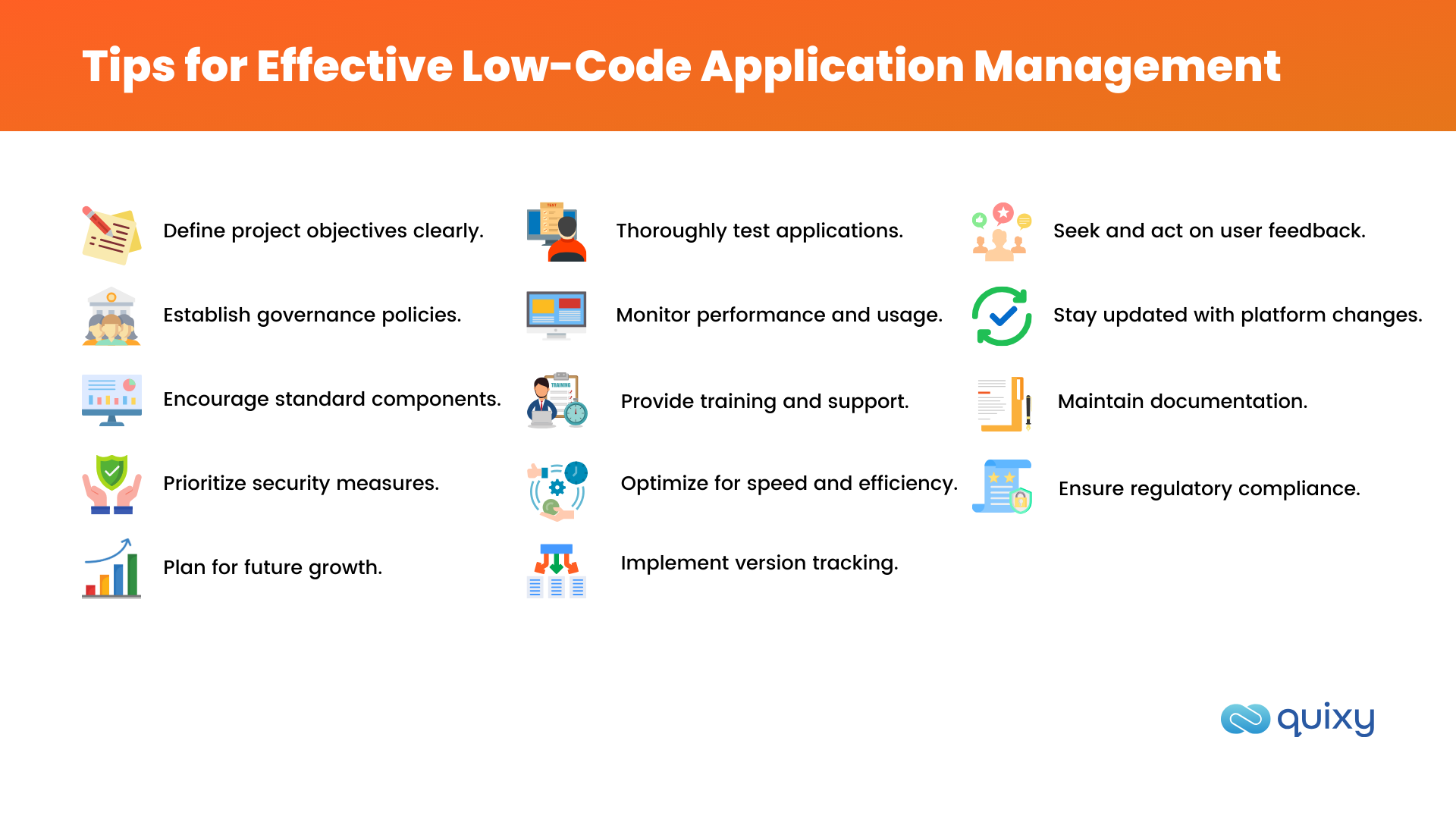
Wondering where to begin with your low-code project? Low-code development promises incredible speed and efficiency, but navigating it successfully requires careful consideration. From choosing the right platform and meticulous planning to ensuring robust security and scalability, our comprehensive guide, “Tips for Low-Code Application Management,” is your roadmap to success. Explore Low-Code Application Management’s intricacies, ensuring your projects thrive in this dynamic landscape. Get ready to unlock the true potential of low-code development and propel your projects to new heights!
What is Low-Code Development?
Before we delve into the tips, let’s clarify low-code development. Low-code development is an approach that allows developers to build applications with minimal hand-coding and manual programming effort. It involves using visual interfaces and pre-built components to accelerate the development process.
Tips for Low-Code Application Management

1. Understand Citizen Development Types
Recognize two distinct types of citizen development: individual and team/company. Each type requires different skill sets and organizational structures. Tailor your approach accordingly to maximize success.
2. Embrace the Low-Code Mindset
Successful low-code application management starts with a mindset shift. Recognize the power of low-code in accelerating development and reducing costs. Embrace the idea that non-technical team members can actively participate in the development process, fostering collaboration and innovation.
3. Identify Opportunities
You need to find citizen development opportunities that involve identifying intersections between your desired outcomes and changing adaptability. Look for areas where low-code solutions can make the most impact.
3. Choose the Right Low-Code Platform
Selecting the appropriate low-code platform is crucial for success. Evaluate platforms based on your specific needs, such as scalability, integration capabilities, and the availability of pre-built templates. Consider platforms like https://contgpt.com to streamline your low-code development journey.
Also Read: 10-Step Guide On How to Choose The Right Low-Code Development Platform
4. Plan Carefully
Effective planning is the cornerstone of any successful project. Create a detailed project plan that outlines your objectives, timelines, and resource allocation. A well-thought-out plan ensures that your low-code application development stays on track.
5. Evaluate Risk and Complexity
Evaluating risk (privacy, data) and complexity (custom coding, integrations) when determining the suitability of citizen development projects. A thorough assessment helps you make informed decisions.
6. Foster Collaboration
Low-code development encourages collaboration between IT and business teams. Encourage open communication, feedback, and brainstorming sessions to ensure that the final application aligns with business goals.
6. Security First
Security should never be an afterthought. Prioritize security by implementing authentication, authorization, and data encryption measures. Regularly update your application to patch vulnerabilities and stay protected.
7. Guidance from IT Departments
IT departments should guide citizen developers with guardrails for security, data protection, and compliance. This guidance fosters effective alignment and collaboration across all departments.
8. Continuous Testing and Quality Assurance
Implement a rigorous testing and quality assurance process. Regularly test your application for functionality, performance, and user experience to identify and address issues promptly.
9. Monitor and Optimize
Continuous monitoring is vital to ensure your low-code applications perform optimally. Use analytics tools to gather data and make data-driven decisions for improvements.
10. Think Big, Start Small, Scale Rapidly
Think big, start small, and scale rapidly for successful citizen development. Consider complexity levels and choose appropriate platforms to avoid frustration and ensure smooth scaling.
Also Read: How Low-Code Empowers Citizen Developers?
11. Stay Informed
The technology landscape is always changing. Stay informed about the latest developments in low-code technology to keep your applications up-to-date and competitive.
12. Seek User Feedback
Finally, listen to your users. Collect feedback and make iterative improvements based on user suggestions and needs. Happy users are the key to the success of your low-code applications.
13. Find Modular Platforms
Find citizen development platforms that offer modularity and cover your maximum requirements to achieve satisfaction. This enables effective operation within that space.
14. Synergy is Key
Healthy citizen development programming encompasses the synergy between people, technology, and the development process. Encourage collaboration and alignment to maximize the benefits of low-code development.
By incorporating these tips into your low-code development strategy, you’ll be better equipped to harness the power of citizen development effectively and achieve outstanding results.

Conclusion
Mastering the art of low-code application management opens doors to innovation, efficiency, and success. By starting small, thinking big, and embracing collaboration, you lay a strong foundation for your low-code journey. Selecting the right platform, planning meticulously, and prioritizing security ensures that your applications meet your immediate needs and scale effortlessly. Staying informed and listening to user feedback keeps your applications competitive and user-centric. In this dynamic landscape of software development, low code is your key to agile, efficient, and secure application management, setting you on a path to outpace the competition and drive lasting success. So, take these tips to heart and embark on your low-code adventure with confidence!
Frequently Answer Questions (FAQs)
Q. What Is Low-Code Application Management?
Low-Code Application Management streamlines development by minimizing manual coding. It employs visual interfaces and pre-built components to accelerate application creation, boosting efficiency and productivity.
Q. How Can I Start with Low-Code Development?
To initiate low-code development, select a suitable platform, meticulously plan your project, commence with smaller tasks, and gradually expand. This approach allows for confidence-building and enhances overall project success.
Q. How Do I Ensure Security in Low-Code Applications?
Security in low-code applications is achieved through robust measures such as authentication, authorization, data encryption, regular updates, and comprehensive testing. These safeguards protect sensitive data and minimize vulnerabilities.
Q. What Should I Consider When Selecting a Low-Code Platform?
When choosing a low-code platform, consider usability, scalability, integration capabilities, and security features. Ensure alignment with your project objectives to achieve optimal results and successful application development.
Q. How Can I Stay Informed About Low-Code Technology Trends?
Staying informed about low-code technology trends is crucial to remain competitive and make informed decisions. To do so, you can start by regularly following industry news and updates. Subscribe to resources, newsletters, blogs, and websites specializing in low-code and citizen development.
Subscribe
Login
Please login to comment
0 Comments
Oldest















